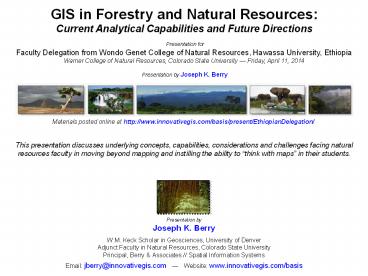Presentation by Joseph K. Berry - PowerPoint PPT Presentation
Title:
Presentation by Joseph K. Berry
Description:
GIS in Forestry and Natural Resources: Current Analytical Capabilities and Future Directions Presentation for Faculty Delegation from Wondo Genet College of Natural ... – PowerPoint PPT presentation
Number of Views:37
Avg rating:3.0/5.0
Title: Presentation by Joseph K. Berry
1
GIS in Forestry and Natural Resources Current
Analytical Capabilities and Future Directions
Presentation for Faculty Delegation from Wondo
Genet College of Natural Resources, Hawassa
University, Ethiopia Warner College of Natural
Resources, Colorado State University Friday,
April 11, 2014 Presentation by Joseph K. Berry
Materials posted online at http//www.innovativegi
s.com/basis/present/EthiopianDelegation/
This presentation discusses underlying concepts,
capabilities, considerations and challenges
facing natural resources faculty in moving beyond
mapping and instilling the ability to think with
maps in their students.
Presentation byJoseph K. Berry W.M. Keck
Scholar in Geosciences, University of
Denver Adjunct Faculty in Natural Resources,
Colorado State UniversityPrincipal, Berry
Associates // Spatial Information Systems Email
jberry_at_innovativegis.com Website
www.innovativegis.com/basis
2
Geotechnology as a Mega-Technology
Geotechnology is one of the three "mega
-technologies" for the 21st century and promises
to forever change how we conceptualize, utilize
and visualize spatial relationships in
scientific research and commercial applications
(U.S. Department of Labor)
Computer Mapping (70s) Spatial Database
Management (80s)
Map Analysis (90s) Multimedia Mapping (00s)
is Where What
Why So What and What If
(Berry)
3
Grid-based Data Organization (Numerical Context)
Spatial Analysis and Statisticsuse
map-ematical operations to analyze mapped data
for a better understand of geographic patterns
and relationships.
(Berry)
4
Example of Grid-based Organization (Raster,
Continuous)
(Berry)
5
Calculating Slope and Flow (Map Analysis)
(Berry)
6
Deriving Erosion Potential Buffers
(Berry)
7
Calculating Effective Distance (variable-width
buffers)
(Berry)
8
Evaluating Habitat Suitability (Binary, Ranking
and Rating Models)
(Berry)
9
Conveying Suitability Model Logic (Flowchart of
Model Logic)
(Berry)
10
Evaluating Habitat Suitability (hands-on example
of a Rating Model)
(Berry)
11
Evaluating Habitat Suitability
Additional criteria can be added
- Hugags would prefer to be in/near forested areas
- Hugags would prefer to be near water
(Berry)
12
The Softer Side of GIS (The NR Experience)
(Berry)
13
GIS Development Cycle (where weve been)
but todays digital map expression involves
radically different technologies with extremely
high expectations that are moving Natural
Resources Management beyond mapping to analysis
of spatial patterns and relationships will
science and education lead or simply follow
geospatial technology?
Contemporary GIS
But keep in mind NR is about doing the right
thing at the right place and at the right
time it identifies and responds to variability
within a landscape it augments indigenous
knowledge (not a replacement)
these are expressions of GIS as an
Analytical Tool
(Berry)
14
GIS Development Cycle (where were heading)
The Early Years
(Berry)
15
Grid-based Map Data (geo-registered matrix of map
values)
the bottom line is that All spatial topology
is inherent in the grid.
(Berry)
16
So Whats the Point?
- Current GIS education in NR for the most part
insists that non-GIS students interested in
understanding map analysis and modeling must be
tracked into general GIS courses that are
designed for GIS specialists, - and that the material presented primarily focus
on commercial GIS software mechanics - that GIS-specialists need to know to function in
the workplace.
2) However, solutions to complex spatial problems
need to engage domain expertise in GIS
outreach to other disciplines to establish
spatial reasoning skills needed for effective
solutions that integrate a multitude of
disciplinary and general public perspectives.
3) Grid-based map analysis and modeling involving
Spatial Analysis and Spatial Statistics is in
large part, simply extensions of traditional
mathematics and statistics.
4) The recognition by the GIS community that
quantitative analysis of maps is a reality and
the recognition by the STEM community that
spatial relationships exist and are quantifiable
should be the glue that binds the two
perspectives.
(Berry)
17
Where to Go from Here































